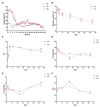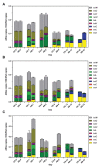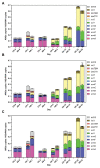Swine Manure Composting With Compound Microbial Inoculants: Removal of Antibiotic Resistance Genes and Their Associations With Microbial Community
- PMID: 33250880
- PMCID: PMC7673438
- DOI: 10.3389/fmicb.2020.592592
Swine Manure Composting With Compound Microbial Inoculants: Removal of Antibiotic Resistance Genes and Their Associations With Microbial Community
Abstract
In this study, compound microbial inoculants, including three Bacillus strains and one Yeast strain, were inoculated into swine manure composting to explore the effects on antibiotic resistance genes (ARGs) and mobile genetic elements (MGEs), microbial community structure, and pathogenic bacteria. The results indicated that the abundances of the detected ARGs ranged from 3.6 × 103 to 1.13 × 108 copies/g. The ARGs with the highest abundance was sul2, and the lowest was blaCTX. Composting removes most of the ARGs and MGEs by 22.8-99.7%. These ARGs were significantly reduced during the thermophilic phase of compost. The removal rate of ARGs at the different layers of compost pile was different as follows: middle layer > upper layer > lower layer. But some ARGs proliferated significantly in the maturation phase of compost, especially the sulfonamide resistance genes. Compound microbial inoculants increased the temperature of compost, accelerated water loss, nitrogen fixation, and increased the removal rate of β-lactamase resistance genes, the transposon gene tn916 and part of tetracycline resistance genes by 3.7-23.8% in compost. Compound microbial inoculants changed the community structure and increased the Bacillus abundance in the thermophilic phase of compost. And it was helpful for removing pathogens during composting. The addition of compound microbial inoculants causes the decrease of Firmicutes and the increase of Bacteroidetes, which may be related to the removal and proliferation of ARGs.
Keywords: 16S rRNA sequencing; aerobic composting; antibiotic resistance genes; compound microbial inoculants; swine manure.
Copyright © 2020 Li, Cao, Mo, Yao, Ren and Wu.
Figures








Similar articles
-
Enhanced removal of antibiotic resistance genes and mobile genetic elements during swine manure composting inoculated with mature compost.J Hazard Mater. 2021 Jun 5;411:125135. doi: 10.1016/j.jhazmat.2021.125135. Epub 2021 Jan 13. J Hazard Mater. 2021. PMID: 33858100
-
Removal of antibiotic resistance genes in pig manure composting influenced by inoculation of compound microbial agents.Bioresour Technol. 2020 Dec;317:123966. doi: 10.1016/j.biortech.2020.123966. Epub 2020 Aug 7. Bioresour Technol. 2020. PMID: 32836032
-
Effects of superabsorbent polymers on the abundances of antibiotic resistance genes, mobile genetic elements, and the bacterial community during swine manure composting.Bioresour Technol. 2017 Nov;244(Pt 1):658-663. doi: 10.1016/j.biortech.2017.08.016. Epub 2017 Aug 5. Bioresour Technol. 2017. PMID: 28813691
-
Key factors driving the fate of antibiotic resistance genes and controlling strategies during aerobic composting of animal manure: A review.Sci Total Environ. 2021 Oct 15;791:148372. doi: 10.1016/j.scitotenv.2021.148372. Epub 2021 Jun 8. Sci Total Environ. 2021. PMID: 34139488 Review.
-
Fate of Antibiotic Resistance Genes and Changes in Bacterial Community With Increasing Breeding Scale of Layer Manure.Front Microbiol. 2022 Mar 9;13:857046. doi: 10.3389/fmicb.2022.857046. eCollection 2022. Front Microbiol. 2022. PMID: 35356511 Free PMC article. Review.
Cited by
-
Regulation of nitrogen transformation and microbial community by inoculation during livestock manure composting.Environ Microbiol Rep. 2024 Apr;16(2):e13256. doi: 10.1111/1758-2229.13256. Environ Microbiol Rep. 2024. PMID: 38575150 Free PMC article.
-
Potential of the livestock industry environment as a reservoir for spreading antimicrobial resistance.Open Vet J. 2025 Feb;15(2):504-518. doi: 10.5455/OVJ.2025.v15.i2.2. Epub 2025 Feb 28. Open Vet J. 2025. PMID: 40201833 Free PMC article. Review.
-
Industrial Composting of Sewage Sludge: Study of the Bacteriome, Sanitation, and Antibiotic-Resistant Strains.Front Microbiol. 2021 Dec 24;12:784071. doi: 10.3389/fmicb.2021.784071. eCollection 2021. Front Microbiol. 2021. PMID: 35003014 Free PMC article.
-
Fate of Horizontal-Gene-Transfer Markers and Beta-Lactamase Genes during Thermophilic Composting of Human Excreta.Microorganisms. 2023 Jan 24;11(2):308. doi: 10.3390/microorganisms11020308. Microorganisms. 2023. PMID: 36838273 Free PMC article.
-
Occurrence and dissemination of antibiotic resistance genes in the Yellow River basin: focused on family farms.Environ Sci Pollut Res Int. 2024 Mar;31(11):16328-16341. doi: 10.1007/s11356-024-32290-5. Epub 2024 Feb 5. Environ Sci Pollut Res Int. 2024. PMID: 38316741
References
LinkOut - more resources
Full Text Sources

